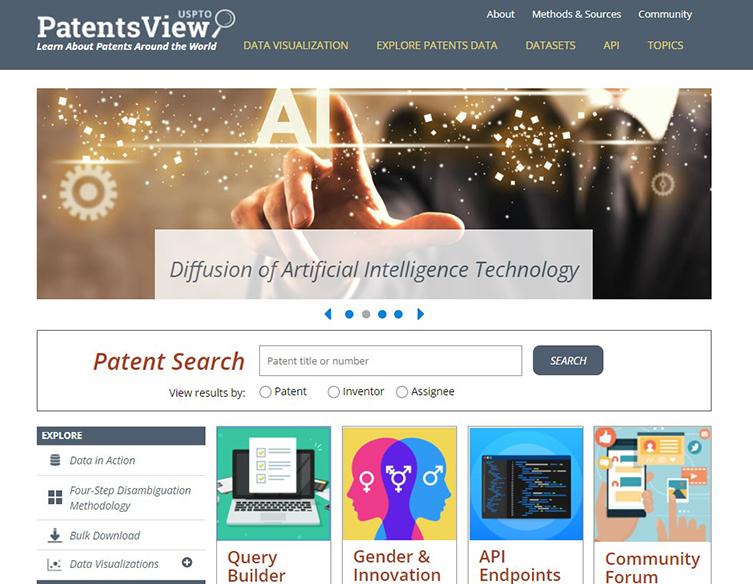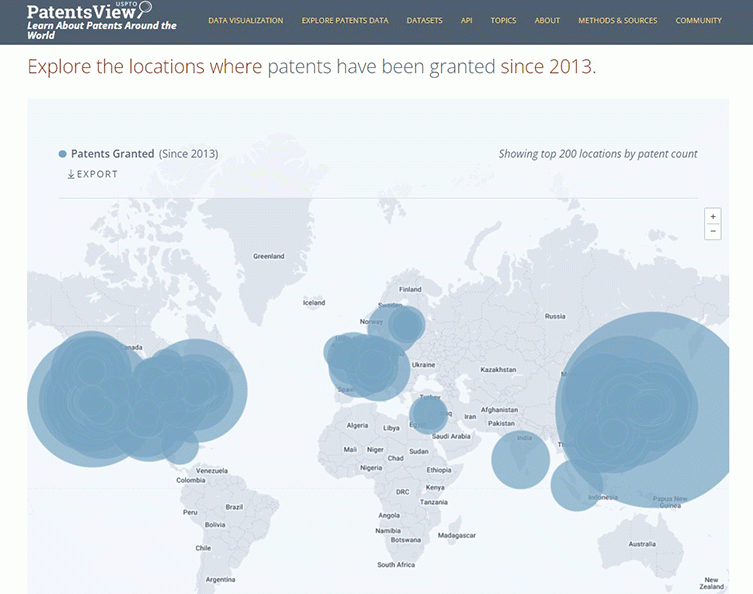PatentsView: Patent Data Exploration Platform
Innovation is centrally important to economic development. The health of the economy can be measured in part by the number, type, and quality of patents issued by patent-granting authorities such as the U.S. Patent and Trademark Office (USPTO). The USPTO’s mission is to encourage innovation and entrepreneurship in the U.S., and this is supported by its open-data platform.
Part of that platform, PatentsView, offers 50 years of information about investors, their organizations, and their locations. Established in 2012 and led by AIR, PatentsView is a collaboration among the USPTO, AIR, researchers at the University of Massachusetts Amherst, the U.S. Department of Agriculture, New York University, the University of California at Berkeley, Twin Arch Technologies, and Periscopic. It was developed as a web-based tool for the public and offers a variety of ways to interactively engage with its data.

The Challenge
The USPTO releases data related to patenting activity on a weekly basis for public consumption. Inventors (people) or assignees (organizations, companies, or firms) apply for patents by mail or online, then USPTO staff process and publish this information. These data are complex and inconsistent over time and contain numerous variations among patent information. These can be misspellings, abbreviations, and other superficial lettering changes. For example, if “Johnny Sir” is the third inventor listed on a patent for Fuji camera film and “Johnny M. Sir” is the first inventor listed for a Kodak printing mechanism, how are researchers to know if these two Johnny individuals represent the same inventor or different ones?
With this example in mind, the challenge is matching inventors, organizations, and locations to themselves over the course of time. Under these conditions, performing longitudinal analysis based on these entities was quantifiably impossible.
Our Role
PatentsView leverages cutting-edge machine learning and database engineering methods and tools to identify unique individuals potentially patenting under the same name. Information from PatentsView can also be used to examine trends in patent investment, such as a report looking at women inventors specifically.
AIR, alongside its partners, developed the PatentsView platform and web application for use by researchers, analysts, entrepreneurs, educators, and patent examiners. PatentsView capabilities include:
- Data exploration: An exploratory data visualization platform allows users to explore comprehensive detailed views for each patent, inventor, assignee organization, and location.
- Search and download: A powerful search and download system allows users to find and access the data they need quickly and efficiently.
- API: An application programming interface (API) drastically improves interoperability by giving users programmatic access to the data.
- Bulk data retrieval: A bulk data download system enables users to build their own application with raw and disambiguated data.
- Topical modeling: Modules, such as those related to Gender & Innovation and AI technology provides valuable insight into the demographics of patent submitters.

Outcome
The algorithms implemented by the AIR and its partners can identify unique entities with high accuracy. As a result of this, PatentsView products are utilized by thousands of users. Per month, the system averages:
- 16,000 page views
- 2,500 bulk data downloads
- 1,500 search & download requests
- 3 million API queries
In addition to maintaining an online forum to provide a space for ongoing interaction with and feedback from the user community, PatentsView also conducts workshops and organizes an Advisory council to develop ideas and define future direction for the PatentsView Project. Please navigate to PatentsView Events for a full list of past and future community events.
The PatentsView platform is also widely used in academic and research circles. From January 1, 2020, to August 1, 2022, 483 unique research publications (including working papers and white papers) have cited PatentsView as a primary data source, including papers published in Management Science, PLOS ONE, Regional Science, Northwestern University Law Review, Scientometrics, and the Journal of Operations Management.
Considerations for Diversity, Equity, Inclusion, and Accessibility
Addressing bias is one of the top goals for the PatentsView team in their work to identify unique individuals potentially patenting under the same name. Name attribution algorithms like those used in PatentsView commonly struggle with performance when working with names of Asian origin (for example inventor names from countries such as China, the Cayman Islands, South Korea, India, Hong Kong, Singapore, and Saudi Arabia).
With the long-term goal of developing sound methods to attribute and detect race/gender of various inventors, the PatentsView Team recently helped USPTO organize the Symposium on Advancing research in inventor demographics. The activities were aimed at engaging the community and experts on various methods of attributing race and gender.
